Ask a group of physicists and philosophers to define “space” and you will likely be stuck in a long discussion that involves deep-sounding but meaningless word combinations such as “the very fabric of space-time itself is a physical manifestation of quantum entropy concepts woven together by the universal nature of location.” On second thought, maybe you should avoid starting deep conversations between philosophers and physicists.
Is space just an infinite emptiness that underlies everything? Or is it the emptiness between things? What if space is neither of these but is a physical thing that can slosh around, like a bathtub full of water?
It turns out that the nature of space itself is one of the biggest and strangest mysteries in the universe. So get ready, because things are about to get … spacey.
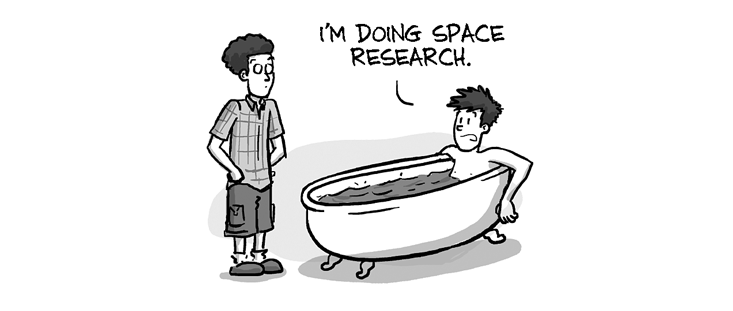
Space, It’s a Thing
Like many deep questions, the question of what space is sounds like a simple one at first. But if you challenge your intuition and reexamine the question, you discover that a clear answer is hard to find.
Most people imagine that space is just the emptiness in which things happen, like a big empty warehouse or a theater stage on which the events of the universe play out. In this view, space is literally the lack of stuff. It is a void that sits there waiting to be filled, as in “I saved space for dessert” or “I found a great parking space.”

If you follow this notion, then space is something that can exist by itself without any matter to fill it. For example, if you imagine that the universe has a finite amount of matter in it, you could imagine traveling so far that you reach a point beyond which there is no more stuff and all the matter in the universe is behind you.1 You would be facing pure empty space, and beyond that, space might extend out to infinity. In this view, space is the emptiness that stretches out forever.

Could Such a Thing Exist?
That picture of space is reasonable and seems to fit with our experience. But one lesson of history is that anytime we think something is obviously true (e.g., the Earth is flat, or eating a lot of Girl Scout cookies is good for you), we should be skeptical and take a step back to examine it carefully. More than that, we should consider radically different explanations that also describe the same experience. Maybe there are theories we haven’t thought of. Or maybe there are related theories where our experience of the universe is just one weird example. Sometimes the hard part is identifying our assumptions, especially when they seem natural and straightforward.
In this case, there are other reasonable-sounding ideas for what space could be. What if space can’t exist without matter—what if it’s nothing more than the relationship between matter? In this view, you can’t have pure “empty space” because the idea of any space at all beyond the last piece of matter doesn’t make any sense. For example, you can’t measure the distance between two particles if you don’t have any particles. The concept of “space” would end when there are no more matter particles left to define it. What would be beyond that? Not empty space.
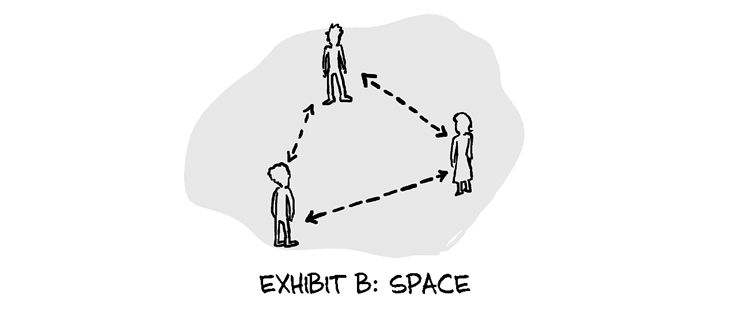
That is a pretty weird and counterintuitive way of thinking about space, especially given that we have never experienced the concept of non-space. But weird never stood in the way of physics, so keep an open mind.
Which Space Is the Place?
Which of these ideas about space is correct? Is space like an infinite void waiting to be filled? Or does it only exist in the context of matter?
It turns out that we are fairly certain that space is neither of these things. Space is definitely not an empty void and it is definitely not just a relationship between matter. We know this because we have seen space do things that fit neither of those ideas. We have observed space bend and ripple and expand.
This is the part where your brain goes, “Whaaaaat … ?”
If you are paying attention, you should be a little confused when you read the phrases “bending of space” and “expanding of space.” What could that possibly mean? How does it make any sense? If space is an idea, then it can’t be bent or expanded any more than it can be chopped into cubes and sautéed with cilantro.2 If space is our ruler for measuring the location of stuff, how do you measure the bending or expanding of space?
Good questions! The reason this idea of space bending is so confusing is that most of us grow up with a mental picture of space as an invisible backdrop in which things happen. Maybe you imagine space to be like that theater stage we mentioned before, with hard wooden planks as a floor and rigid walls on all sides. And maybe you imagine that nothing in the universe could bend that stage because this abstract frame is not part of the universe but something that contains the universe.
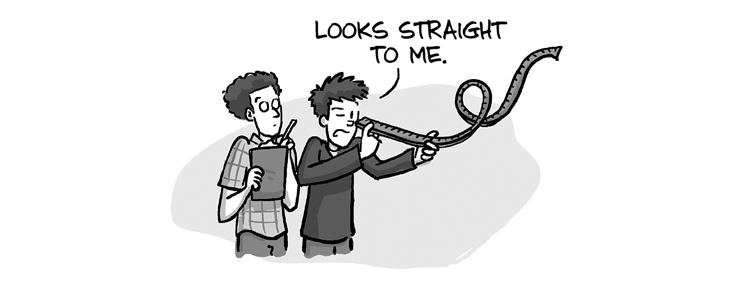
Unfortunately, that is where your mental picture goes wrong. To make sense of general relativity and think about modern ideas of space, you have to give up the idea of space as an abstract stage and accept that it is a physical thing. You have to imagine that space has properties and behaviors, and that it reacts to the matter in the universe. You can pinch space, squeeze it, and, yes, even fill it with cilantro.3
At this point, your brain might be sounding “what the #@#$?!?!” nonsense alarms. That is totally understandable. Prepare to bear with us, because the real craziness is yet to come. Your nonsense alarms will be exhausted by the time we’re done. But we need to unpack these concepts carefully to understand the ideas here and appreciate the truly strange and basic mysteries about space that remain unanswered.
Space Goo, You’re Swimming in It
How can space be a physical thing that ripples and bends, and what does that mean?
It means that instead of being like an empty room (a really big room) space is more like a huge blob of thick goo. Normally, things can move around in the goo without any problems, just like we can move around a room full of air without noticing all the air particles. But under certain circumstances, this goo can bend, changing the way that things move through it. It can also squish and make waves, changing the shape of the things inside it.
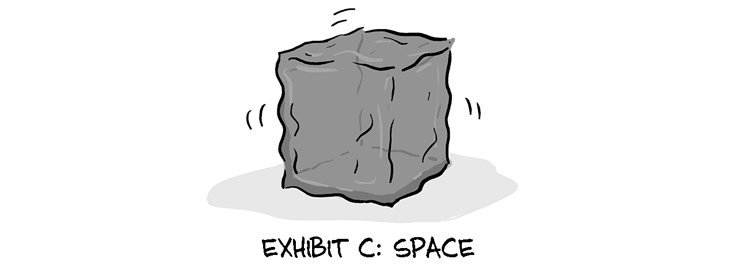
This goo (we’ll call it “space goo”) is not a perfect analogy for the nature of space, but it’s an analogy that helps you imagine that the space you are sitting in right now at this moment is not necessarily fixed and abstract.4 Instead, you are sitting in some concrete thing, and that thing can stretch or jiggle or distort in ways that you may not be perceiving.
Maybe a ripple of space just passed through you. Or maybe we are being stretched in an odd direction at this moment and don’t even know it. In fact, we didn’t even notice until recently that the goo did anything but sit there, goo-ing nowhere, which is why we confused it with nothingness.
So what can this space goo do? It turns out it can do a lot of weird things.
First, space can expand. Let’s think carefully for a minute about what it means for space to expand. That means things get farther apart from each other without actually moving through the goo. In our analogy, imagine that you are sitting in the goo, and suddenly the goo started growing and expanding. If you were sitting across from another person, that person would now be farther away from you without either of you having moved relative to the goo.
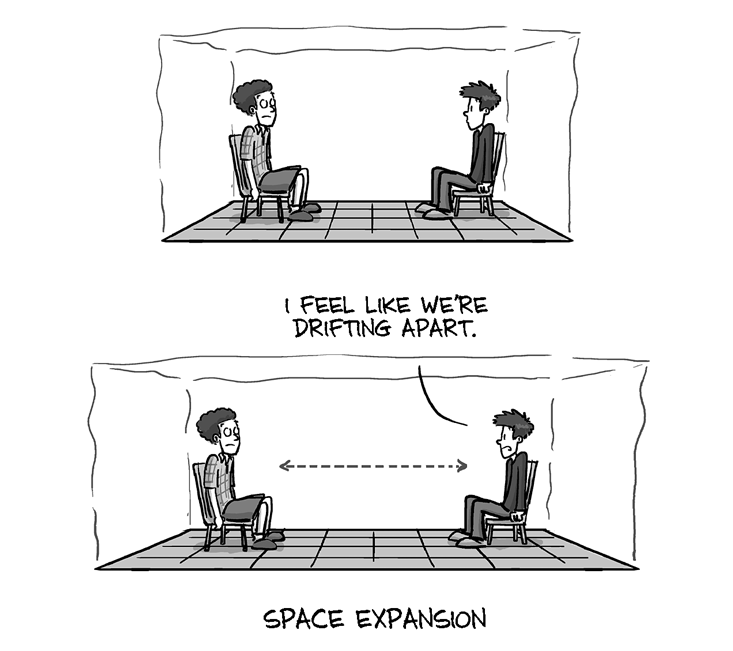
How could we know that the goo expanded? Wouldn’t a ruler we use to measure the goo also expand? It’s true that the space between all the atoms in the ruler would expand, pulling them apart. And if our ruler was made out of extra-soft taffy, it would also expand. But if you use a rigid ruler, all of its atoms would hold on to one another tightly (with electromagnetic forces), and the ruler would stay the same length, allowing you to notice that more space was created.
And we know that space can expand because we have seen it expanding—this is how dark energy was discovered. We know that in the early universe space expanded and stretched at shocking rates, and that a similar expansion is still happening today.

We also know that space can bend. Our goo can be squished and deformed just like taffy can. We know this because in Einstein’s theory of general relativity that’s what gravity is: the bending of space.5 When something has mass, it causes the space around it to distort and change shape.
When space changes shape, things no longer move through it the way you might first imagine. Rather than moving in a straight line, a baseball passing through a blob of bent goo will curve along with it. If the goo is severely distorted by something heavy, like a bowling ball, the baseball might even move in a loop around it—the same way the moon orbits the Earth, or the Earth orbits the sun.
And this is something we can actually see with our naked eyes! Light, for example, bends its path when it passes near massive objects like our sun or giant blobs of dark matter. If gravity was just a force between objects with mass—rather than the bending of space—then it shouldn’t be able to pull on photons, which have no mass. The only way to explain how light’s path can be bent is if it’s the space itself that is bending.
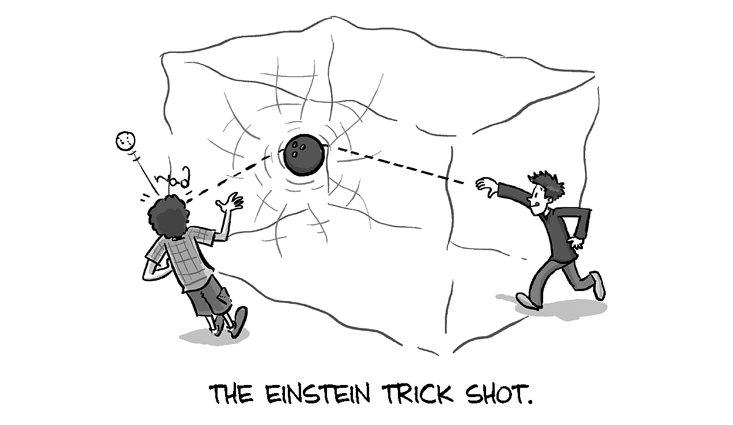
Finally, we know that space can ripple. This is not too far-fetched given that we know that space can stretch and bend. But what is interesting is that the stretching and bending can propagate across our space goo; this is called a gravitational wave. If you cause a sudden distortion of space, that distortion will radiate outward like a sound wave or a ripple inside of a liquid. This kind of behavior could only happen if space has a certain physical nature to it and is not just an abstract concept or pure emptiness.
We know this rippling behavior is real because (a) general relativity predicts these ripples, and (b) we have actually sensed these ripples. Somewhere in the universe, two massive black holes were locked in a frenzied spin around each other, and as they spun, they caused huge distortions in space that radiated outward into space. Using very sensitive equipment, we detected those space ripples here on Earth.
You can think of these ripples as waves of space stretching and compressing. Actually, when a space ripple passes through, space shrinks in one direction and expands in another direction.

This Sounds Ridic-goo-lous. Are You Sure?
As crazy as it may sound that space is a thing and not just pure emptiness, this is what our experience of the universe tells us. Our experimental observations make it pretty clear that the distance between objects in space is not measured on an invisible abstract backdrop but depends on the properties of the space goo in which we all live, eat cookies, and chop cilantro.
But while thinking of space as a dynamic thing with physical properties and behaviors might explain weird phenomena like space bending and stretching, it only leads to more questions.
For example, you might be tempted to say that what we used to call space should now be called physics goo (“phgoo”) but that this goo has to be in something, which we could now call space again. That would be clever, but as far as we know (which to date is not very far), the goo does not need to be in anything else. When it bends and curves, this is intrinsic bending that changes the relationships between parts of space, not the bending of the goo relative to some larger room that it fills.
But just because our space goo doesn’t need to sit inside of something else doesn’t mean that it is not sitting inside something else. Perhaps what we call space is actually sitting inside some larger “superspace.”6 And perhaps that superspace is like an infinite emptiness, but we have no idea.
Is it possible to have parts of the universe without space? In other words, if space is a goo, is it possible for there to be not-goo, or the absence of goo? The meaning of those concepts is not very clear because all of our physical laws assume the existence of space, so what laws could operate outside of space? We have no idea.
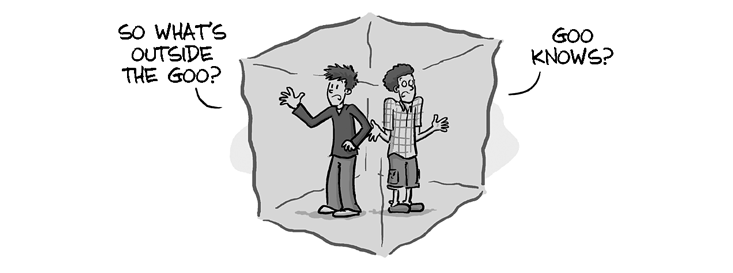
The fact is that this new understanding of space as a thing has come recently, and we are at the very beginning of understanding what space is. In many ways, we are still hobbled by our intuitive notions. These notions served us well when early men and women were hunting for game and foraging for prehistoric cilantro, but we need to break the shackles of these concepts and realize that space is very different from what we imagined.
Straight Thinking about Bent Space
If your brain is not yet hurting from all these gooey space-bending concepts, here is another mystery about space: Is space flat or curved (and if it’s curved, which way does it curve)?

These are crazy questions, but they are not that hard to ask once you accept the notion that space is malleable. If space can bend around objects with mass, could it have an overall curvature to it? It’s like asking if our goo is flat: You know that it can jiggle and deform if you push any point on it, but does it sag overall? Or does it sit perfectly straight? You can ask these questions about space, too.

Answering these questions about space would have an enormous impact on our notion of the universe. For example, if space is flat, it means that if you travel in one direction forever you could just keep going, possibly to infinity.
But if space is curved, then other interesting things might happen. If space has an overall positive curvature, then going off in one direction might actually make you loop around and come back to the same spot from the opposite direction! This is useful information if, for example, you don’t like the idea of people sneaking up behind you.
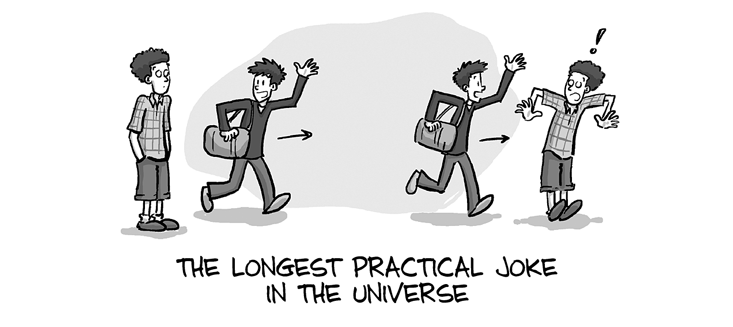
Explaining the idea of curved space is very difficult because our brains are simply not well equipped to visualize concepts like these. Why would they be? Most of our everyday experience (like evading predators or finding our keys) deals with a three-dimensional world that seems pretty fixed (although if we are ever attacked by advanced aliens that can manipulate the curvature of space, we hope we, too, can figure it out quickly).
What would it mean for space to have a curvature? One way to visualize it is to pretend for a second that we live in a two-dimensional world, like being trapped in a sheet of paper. That means we can only move in two directions. Now, if that sheet we live in lies perfectly straight, we say that our space is flat.

But if for some reason that sheet of paper is bent, then we say that the space is curved.

And there are two ways that the paper can be bent. It can all be curved in one direction (called “positive curvature”) or it can be bent in different directions like a horse saddle or a Pringles potato chip (this is called “negative curvature” or “breaking your diet”).
Here is the cool part: if we find out that space is flat everywhere, it means that the sheet of paper (space) could potentially go on forever. But if we find out that space has a positive curvature everywhere, then there’s only one shape that has positive curvature everywhere: a sphere. Or to be more technical, a spheroid (i.e., a potato). This is one way in which our universe could loop around itself. We could all be living in the three-dimensional equivalent of a potato, which means that no matter which direction you go you end up coming back around to the same spot.
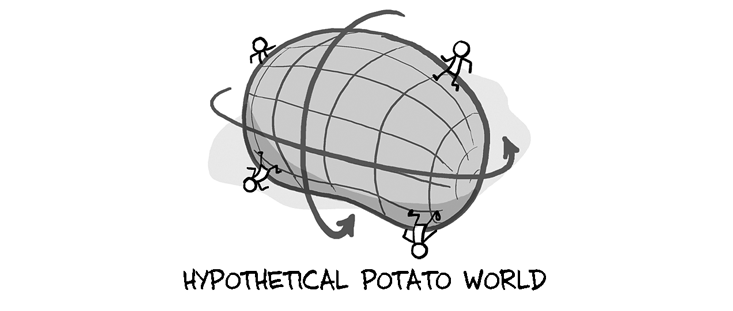
In this case, it turns out that we do have an answer, which is that space does appear to be “pretty flat,” as in space is within 0.4 percent of being flat. Scientists, through two very different methods, have calculated that the curvature of space (at least the space we can see) is very nearly zero.
What are these two ways? One of the ways is by measuring triangles. An interesting thing about curvature is that triangles in a curved space don’t follow the same rules as triangles in flat space. Think back to our sheet-of-paper analogy. A triangle drawn on a flat sheet of paper is going to look different than a triangle drawn on a curved surface.

Scientists have done the equivalent of measuring triangles drawn in our three-dimensional universe by looking at a picture of the early universe and studying the spatial relationship between different points on that picture. And what they found was that the triangles they measured correspond to those of flat space.
The other way in which we know that space is basically flat is by looking at the thing that causes space to curve in the first place: the energy in the universe. According to general relativity, there is a specific amount of energy in the universe (energy density, actually) that will cause space to bend in one direction or the other. It turns out that the amount of energy density that we can measure in our universe is exactly the right amount needed to cause the space that we can see to not bend at all (within a margin of error of 0.4 percent).
Some of you might be disappointed to learn we don’t live in a cool three-dimensional cosmic potato that loops around if you go in one direction forever. Sure, who hasn’t dreamed of doing Evel Knievel–style spins around the entire universe on a rocket motorcycle? But instead of feeling disappointed by the fact that we live in a boring flat universe, you might want to be a little intrigued. Why? Because as far as we know, the fact that we live in a flat universe is a gigantic cosmic-level coincidence.

Think about it. All the mass and energy in the universe is what gives space its curvature (remember that mass and energy distort space), and if we had just a little bit more mass and energy than we have right now, space would have curved one way. And if we had just a little bit less than we have right now, space would have curved the other way. But we seem to have just the right amount to make space perfectly flat as far as we can tell. In fact, the exact amount is about five hydrogen atoms per cubic meter of space. If we had had six hydrogen atoms per cubic meter of space, or four, the entire universe would have been a lot different (curvier and sexier, but different).
And it gets stranger. Since the curvature of space affects the motion of matter, and matter affects the curvature of space, there are feedback effects. This means that if there had been just a little too much matter or not quite enough matter in the early days of the universe, so that we weren’t right at this critical density to make space flat, then it would have pushed things even farther from flat. For space to be pretty flat now means that it had to be extremely flat in the early universe, or there has to be something else keeping it flat.
This is one of the biggest mysteries about space. Not only do we not know what exactly space is, we also don’t know why it happens to be the way it is. Our knowledge in this matter appears to fall … flat.
The Shape of Space
The curvature of space is not the only thing we have deep questions about when it comes to the nature of space. Once you accept that space is not an infinite void but rather a maybe-infinite physical thing with properties, you can ask all kinds of strange questions about it. For example, what is the size and shape of space?
The size and shape of space tell us how much space there is and how it is connected to itself. You might think that since space is flat, and not shaped like a potato or a horse saddle (or a potato on a horse saddle), the idea of the size and shape of space makes no sense. After all, if space is flat, it means that it must go on forever, right? Not necessarily!
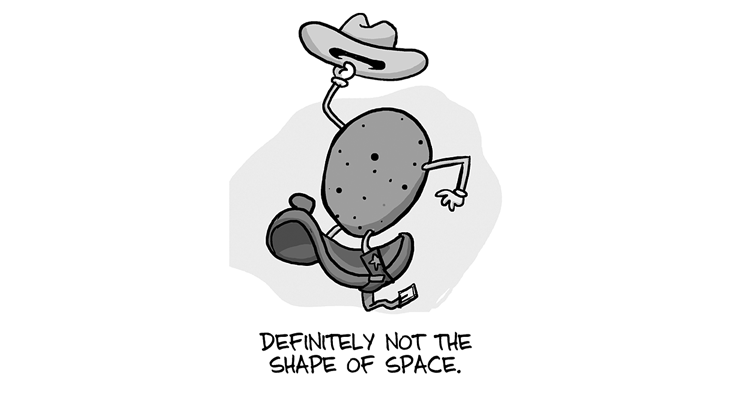
Space can be flat and infinite. Or it could be flat and have an edge to it. Or, even stranger, it could be flat and still loop around itself.
How can space have an edge? Actually, there’s no reason why space can’t have a boundary even if it is flat. For example, a disc is a flat two-dimensional surface with a smooth continuous edge. Perhaps three-dimensional space also has a boundary at some point thanks to some strange geometric property at its edges.
Even more intriguing is the possibility that space can be flat and still loop around itself. It would be like playing one of those video games (like Asteroids or Pac-Man) where if you move beyond the edge of the screen you simply appear on the other side. Space might be able to connect with itself in some way that we are not completely aware of yet. For example, wormholes are theoretical predictions of general relativity. In a wormhole, two different points in space that are far apart can be connected to each other. What if the edges of space are all connected together in a similar way? We have no idea.
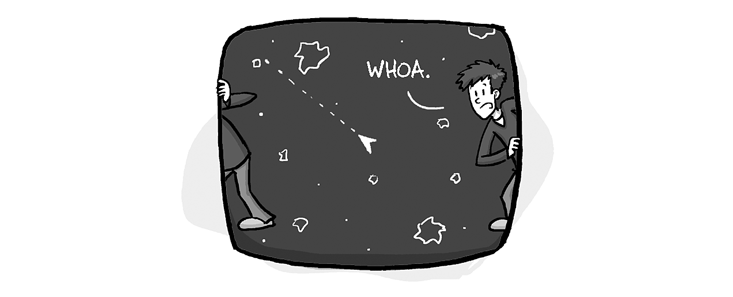
Quantum Space
Finally, you can ask whether space is actually made up of tiny discrete bits of space, like the pixels on a TV screen, or infinitely smooth, such that there are an infinite number of places you can be between two points in space?
Scientists in ancient times might not have imagined that air is made up of tiny discrete molecules. After all, air appears to be continuous. It acts to fill any volume and it has interesting dynamical properties (like wind and weather). Yet we know that all these things we love about air (how it brushes gently against your cheek in a cool summer breeze or how it keeps us from asphyxiating) are actually the combined behavior of billions of individual air molecules, not the fundamental properties of the individual molecules themselves.
The smooth space scenario would appear to make more sense to us. After all, our experience of moving through space is that we glide through it in an easy, continuous way. We don’t jump from pixel to pixel in a jerky fashion the way a video-game character does when it moves across the screen.
Or do we?
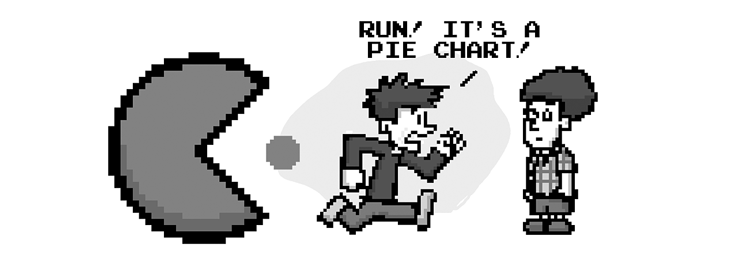
Given our current understanding of the universe, it would actually be more surprising if space turned out to be infinitely smooth. That’s because we know that everything else is quantized. Matter is quantized, energy is quantized, forces are quantized, Girl Scout cookies are quantized. Moreover, quantum physics suggests that there might be a smallest distance that even makes sense, which is about 10−35 meters.7 So from a quantum mechanical perspective, it would make sense if space was quantized. But, again, we really have no idea.
But having no idea hasn’t stopped physicists from imagining crazy possibilities! If space is quantized, that means that when we move across space we are actually jumping from small little locations to other small little locations. In this view, space is a network of connected nodes, like the stations in a subway system. Each node represents a location, and the connections between nodes represent the relationships between these locations (i.e., which one is next to which other one). This is different from the idea that space is just the relationship between matter, because these nodes of space can be empty and still exist.
Interestingly enough, these nodes would not need to sit inside a larger space or framework. They could just … be. In this scenario, what we call space would just be the relationships between the nodes, and all the particles in the universe would just be properties of this space rather than elements in it. For example, they might be vibrational modes of these nodes.

This is not as far-fetched as it sounds. The current theory of particles is based on quantum fields that fill all of space. A field just means there is a number, or a value, associated with every point in that space. In this view, particles are just excited states of these fields. So we are not too far from this kind of theory already.
By the way, physicists love this type of idea, where something that seems fundamental to us (like space) comes out accidentally from something deeper. It gives them the sense that we have peeked behind the curtain to discover a deeper layer of reality. Some even suspect that the relationships between nodes of space are formed by the quantum entanglement of particles, but this is mathematical speculation by a bunch of overcaffeinated theorists.
The Mysteries of Space
If you have read this far and either understood it deeply or just turned your nonsense alarm to mute, then we should not hesitate to explore the craziest concept about space (yes, it gets crazier).
If space is a physical thing—not a backdrop or frame—with dynamic properties such as twists and ripples, perhaps even built out of quantized bits of space, then we have to wonder: What else can space do?
Like air, perhaps it has different states and phases. Under extreme conditions, maybe it can arrange itself in very unexpected ways or have weird unexpected properties in the same way that air behaves differently whether it’s in liquid, gas, or solid form. Perhaps the space we know and love and occupy (sometimes more than we’d like) is only one rare type of space and there are other types of space out there in the universe just waiting for us to figure out how to create and manipulate them.
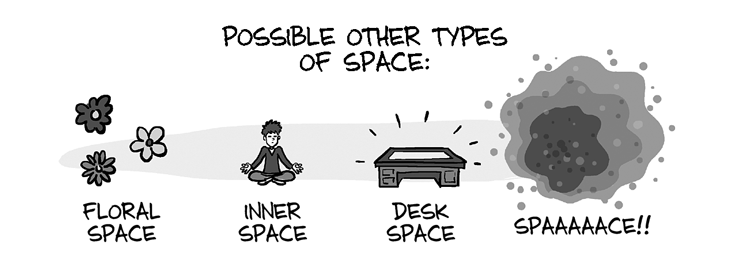
The most intriguing tool we have to answer this question is the fact that space is distorted by mass and energy. In order to understand what space is and what it can do, our best bet is to push it to extremes by looking carefully at places where cosmically huge masses are squeezing and straining it: black holes. If we could explore near black holes, we might see space shredded and chopped in ways that cause our nonsense alarms to explode.
And the exciting thing is that we are closer than ever to being able to probe these extreme deformations of space. Whereas before we were deaf to the ripples of gravitational waves moving through the universe, we now have the ability to listen in to the cosmic events that are shaking and disturbing the goo of space. Perhaps in the near future we will understand more about the exact nature of space and get at these deep questions that are literally all around us.
So don’t space out. And save some space in your brain for the answers.
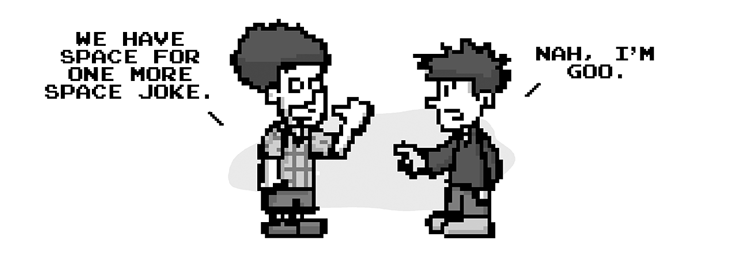
Jorge Cham is the creator of the popular online comic Piled Higher and Deeper, also known as PHD Comics. He earned his Ph.D. in robotics at Stanford.
Daniel Whiteson is a professor of experimental physics at the University of California, Irvine, and a fellow of the American Physical Society. He conducts research using the Large Hadron Collider at CERN.
From We Have No Idea: A Guide to the Unknown Universe by Jorge Cham and Daniel Whiteson, published on May 9, 2017 by Riverhead Books, an imprint of Penguin Publishing Group, a division of Penguin Random House, LLC. Copyright © 2017 by Jorge Cham and Daniel Whiteson.
Lead image credit: Elysee Shen / Getty Images






























